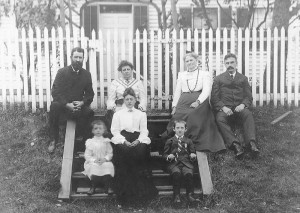True Tales from Canton’s Past: End of the Line
By George T. ComeauThe following is an excerpt from “End of the Line,” the latest installment of True Tales from Canton’s Past by local historian George T. Comeau.
Henry Crane Jr. was the first Crane to live in what is now Canton. He received his property on what is now Green Street in the best way possible — via marriage. Crane married Elizabeth Vose, the daughter of Thomas and Waitstill, on October 18, 1683. In turn, Henry Crane’s son, William, succeeded him in owning the estate and was a shoemaker, or cordwainer, as they were called back then.

The relatives of Isabella Burnham Malcolm Crane at her house in Canton (Courtesy of the Canton Historical Society)
William Crane drew up most of the earliest deeds in our town’s history and was a selectman at various times between 1728 and 1739, as well as our town clerk. When William died in 1742, the pastor of the church reported, “He was a good man, but of late months under much darkness and despondency.”
After the death of William, his son Elihu occupied the homestead. It was Elihu Crane, the deacon of the church, who exorcised the Packeen Ghost. Elihu was a sergeant in the Stoughton Militia, and his family line would serve in distinction in the American Revolution. One of Elihu’s more esoteric duties was to “inspect ye youth on ye Sabbath in time of public worship in our meetinghouse, to inform against or moderately correct them as [he] see fit.” It is likely that corporal punishment was alive and well in the hands of a strict Crane and on the bottoms of indolent boys.
The next generation of the Crane family became increasingly prolific and just as critical in the birth of our nation. In the 1770s there were two men in town who were named Crane. Distant relatives to be sure, but to make matters even more confusing, they were both in the military and ultimately both became generals, and so over time, Nathan, from Green Street, became known as the northern general and Elijah Crane, from South Canton, became known as the southern general. In fact, these two men could not have been more different. In politics Nathan was a rabid Republican, and Elijah was a staunch Federalist.
In Canton’s history, Nathan Crane is what we call a “heavy hitter.” He married twice, served in the Revolutionary War, helped create the town boundaries, brought in the town minister, was on the school committee, signed the petition for the dividing of Stoughton and Canton, defended the War of 1812, and was a member of the Old Stoughton Musical Society. Crane was at the alarm in Lexington and helped defend Dorchester Heights. On June 13, 1776, Crane’s company was at Moon Island and fired upon the remaining British fleet, which fled Boston Harbor. Simply put, Nathanial Crane was critical to the history of our nation and our town. His house stood on land that is now the end of Green and Royall streets.
And from that generation, things began to slow down a bit. Nathan’s son (also named Nathan) was an adjutant in the militia as well as an active member of the Old Stoughton Musical Society. Apparently Nathan Jr. also supplied the woodwork for the first hearse in 1804. In 1784, Nathan Jr. married Betsy Paul and they lived in the old homestead until he died in 1810. Betsy remarried her brother-in-law, Ebenezer Crane, in 1815 and they built a new house across the street on what is now Green Street Extension. When Betsy died, Ebenezer married Betsy Calef in 1827. The house is still standing today and is one of the finest examples of a simple Federal style home in Canton. What is remarkable is that as late as 2006, it still retained its original clapboard siding and is extraordinarily well preserved.
After a few hundred years of Cranes in Canton, the line began to end with the birth of Nathan Crane in 1818. Nathan inherited the house that he was born in and would live there for 82 years. At age 49 Nathan Crane married Isabella Burnham Malcolm and they lived a quiet life in a beautiful house, largely on the money that had been built in savings since the colonial times of the family history. The end of the line was likely a house filled with antiquities, family papers, and dusty ancestral portraits. Isabella died in 1896, and Nathan died in 1900. Both are buried in the family plot at Canton Corner …
See this week’s Canton Citizen to read more about the Crane family in Canton. Click here to order your subscription today.
Short URL: https://www.thecantoncitizen.com/?p=29811










